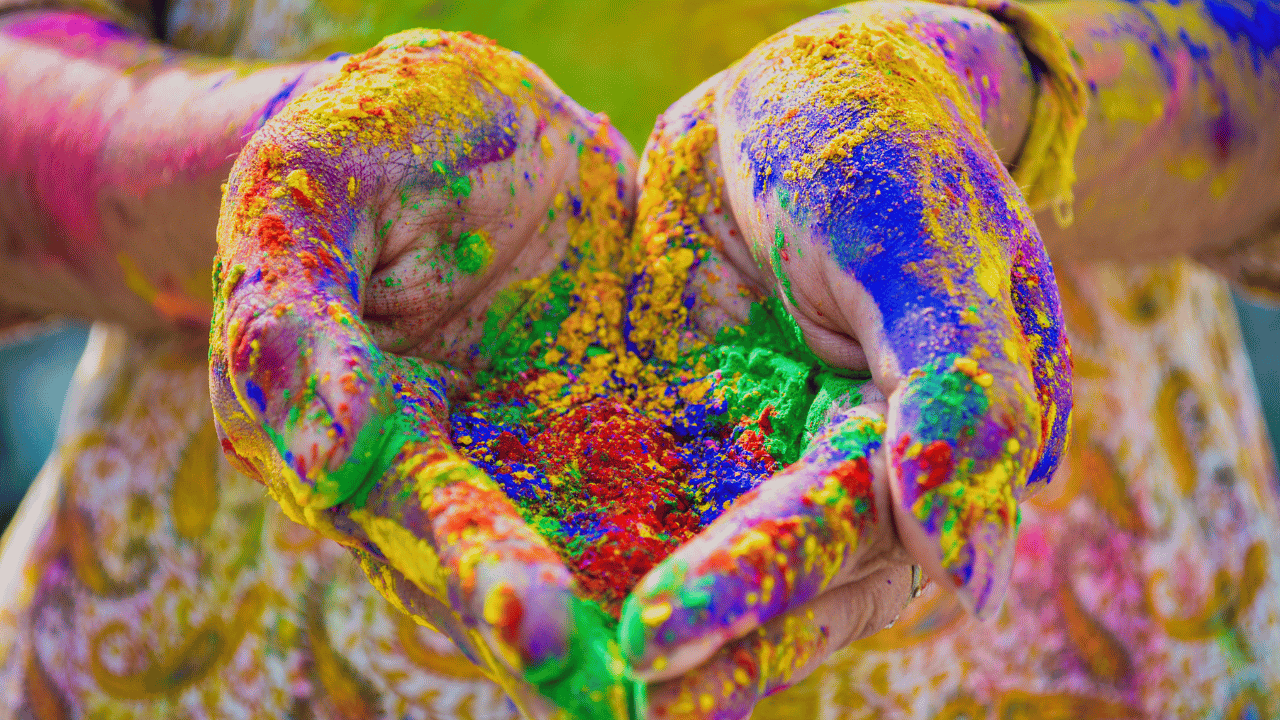India is a country of myriad festivals, and among them, Holi stands out as a vivacious celebration of colors. This event paints the streets and homes with a spectrum of vibrant hues, and it’s not just about the colors. The festival represents love, happiness, and the triumph of good over evil.
Holi: A Brief Overview
Table of Contents
Holi, often referred to as the “Festival of Colors,” is a spring festival. It’s primarily observed in India but has made its mark globally, thanks to the Indian diaspora.
Here’s a quick table detailing some key aspects of Holi:
| Aspect | Description |
|---|---|
| Origin | Ancient Hindu tradition |
| Date | Late February or March, on the Phalgun Purnima (Full Moon) |
| Significance | Triumph of good over evil, celebration of spring and love |
| Main Rituals | Playing with colors, lighting bonfires, singing and dancing |
| Food and Sweets | Gujiya, malpua, puran poli, dahi bhalla, bhang |
| Regions | Celebrated all over India, but particularly vibrant in North |
The Legends Behind Holi
There are several stories associated with Holi’s inception. One popular legend involves the demon king Hiranyakashipu and his son Prahlada. While the king desired everyone to worship him, his son remained a devout follower of Lord Vishnu. Furious, the king plotted to kill Prahlada. He enlisted his sister, Holika, who was immune to fire, to sit in a bonfire with Prahlada. However, due to her ill intent, she burned, while Prahlada remained unharmed. This tale symbolizes the victory of good over evil.
Another story revolves around the playful love of Lord Krishna and Radha. Krishna, with his blue complexion, was unsure if the fair-skinned Radha would like him. On his mother’s advice, he playfully colored Radha’s face, which led to the popular practice of smearing colors on loved ones during Holi.
Rituals and Practices
Holi is celebrated over two days. The first evening, known as Holika Dahan, involves lighting bonfires. People sing, dance, and pray for their loved ones’ wellbeing.
The following day is Rangwali Holi, where everyone plays with colors. Streets come alive with people smearing each other with colorful powders and drenching with water. Musical instruments blare, and there’s a certain infectious energy in the air.
Delicacies of Holi
The festival is also about indulging in mouth-watering delicacies. Some popular ones include:
- Gujiya: A sweet deep-fried dumpling filled with khoya and dried fruits.
- Malpua: Pancake served as a dessert or a snack.
- Bhang: A traditional intoxicant made from cannabis, sugar, and various spices. It’s consumed responsibly by many during Holi.
Regional Variations
Holi is celebrated across India, but the style and traditions can vary.
- North India: Lathmar Holi in Uttar Pradesh sees women playfully hitting men with sticks.
- West Bengal: Here, Holi is known as Dol Jatra, where idols of Krishna and Radha are taken out in processions.
- South India: In some regions, the festival pays homage to Kamadeva, the god of love.
Frequently Asked Questions
How is Holi celebrated in contemporary times outside of India?
As the Indian diaspora has spread globally, so has the enthusiasm for Holi. Many countries, including the USA, UK, Canada, and Australia, have Holi celebrations. These events merge traditional aspects with local flavors, often including music festivals and color runs.
Is it safe to play with all the colors available during Holi?
Not all Holi colors on the market are safe. Earlier, natural sources like flowers and herbs produced colors. However, with commercialization, many artificial colors containing harmful chemicals emerged. It’s crucial to choose organic or herbal colors to ensure skin and environmental safety.
Why is food a significant aspect of Holi?
Festivals in India are often closely linked with food, and Holi is no exception. Preparing and sharing special dishes strengthens communal bonds. The unique sweets and delicacies add another layer of joy to the celebrations.
How can one be a part of Holi celebrations if they’re visiting India?
Tourists can easily partake in Holi celebrations, especially in places like Mathura, Vrindavan, or Jaipur, known for grand Holi festivities. It’s essential to respect local customs, wear appropriate clothing, and be prepared for a vibrant, messy, and fun experience.
Conclusion
The Holi Festival is more than just a splash of color. It’s a reflection of India’s rich culture, traditions, and the undying spirit of unity and joy. Celebrated with zest and zeal, Holi is a testament to the country’s diverse yet cohesive fabric. Whether you’re smearing colors on a loved one’s face or savoring the festive delicacies, the essence of Holi resonates with love, joy, and togetherness. As the streets come alive with a riot of colors, one can’t help but marvel at the beauty of this remarkable festival and its deep-rooted significance in the hearts of millions.

